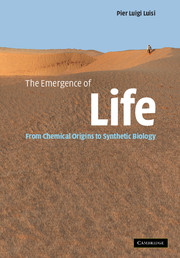Book contents
- Frontmatter
- Contents
- Preface
- Acknowledgments
- List of books on the origin of life
- 1 Conceptual framework of research on the origin of life on Earth
- 2 Approaches to the definitions of life
- 3 Selection in prebiotic chemistry: why this … and not that?
- 4 The bottle neck: macromolecular sequences
- 5 Self-organization
- 6 The notion of emergence
- 7 Self-replication and self-reproduction
- 8 Autopoiesis: the logic of cellular life
- 9 Compartments
- 10 Reactivity and transformation of vesicles
- 11 Approaches to the minimal cell
- Outlook
- References
- Index
1 - Conceptual framework of research on the origin of life on Earth
Published online by Cambridge University Press: 17 December 2010
- Frontmatter
- Contents
- Preface
- Acknowledgments
- List of books on the origin of life
- 1 Conceptual framework of research on the origin of life on Earth
- 2 Approaches to the definitions of life
- 3 Selection in prebiotic chemistry: why this … and not that?
- 4 The bottle neck: macromolecular sequences
- 5 Self-organization
- 6 The notion of emergence
- 7 Self-replication and self-reproduction
- 8 Autopoiesis: the logic of cellular life
- 9 Compartments
- 10 Reactivity and transformation of vesicles
- 11 Approaches to the minimal cell
- Outlook
- References
- Index
Summary
Introduction
The main assumption held by most scientists about the origin of life on Earth is that life originated from inanimate matter through a spontaneous and gradual increase of molecular complexity.
This view was given a well-known formulation by Alexander Oparin (Oparin, 1924, 1953 and 1957), a brilliant Russian chemist who was influenced both by Darwinian theories and by dialectical materialism. A similar view coming from a quite different context was put forward by J. B. Haldane (Haldane, 1929; 1954; 1967). By definition, this transition to life via prebiotic molecular evolution excludes panspermia (the idea that life on Earth comes from space) and divine intervention. If we look at Figure 1.1 without prejudice, we realize that Oparin's proposition is extremely bold. The idea that molecules, without the help of enzymes or DNA, could spontaneously assemble into molecular structures of increasing complexity, order, and functionality, appears at first sight to go against chemical and thermodynamic common sense. This view, which modern biology generally takes for granted, appears in most college textbooks, specialized literature, and mass media. The background of Figure 1.1 is the continuity principle (Oparin, 1924; De Duve, 1991; Morowitz, 1992; Crick, 1996; Eigen and Winkler-Oswatitisch, 1992; Orgel, 1973; 1994), which sets a gradual continuity from inorganic matter to organic molecules and from these to molecular complexes, up to the onset of cellular life, with no qualitative gap between each stage.
Information
- Type
- Chapter
- Information
- The Emergence of LifeFrom Chemical Origins to Synthetic Biology, pp. 1 - 16Publisher: Cambridge University PressPrint publication year: 2006
